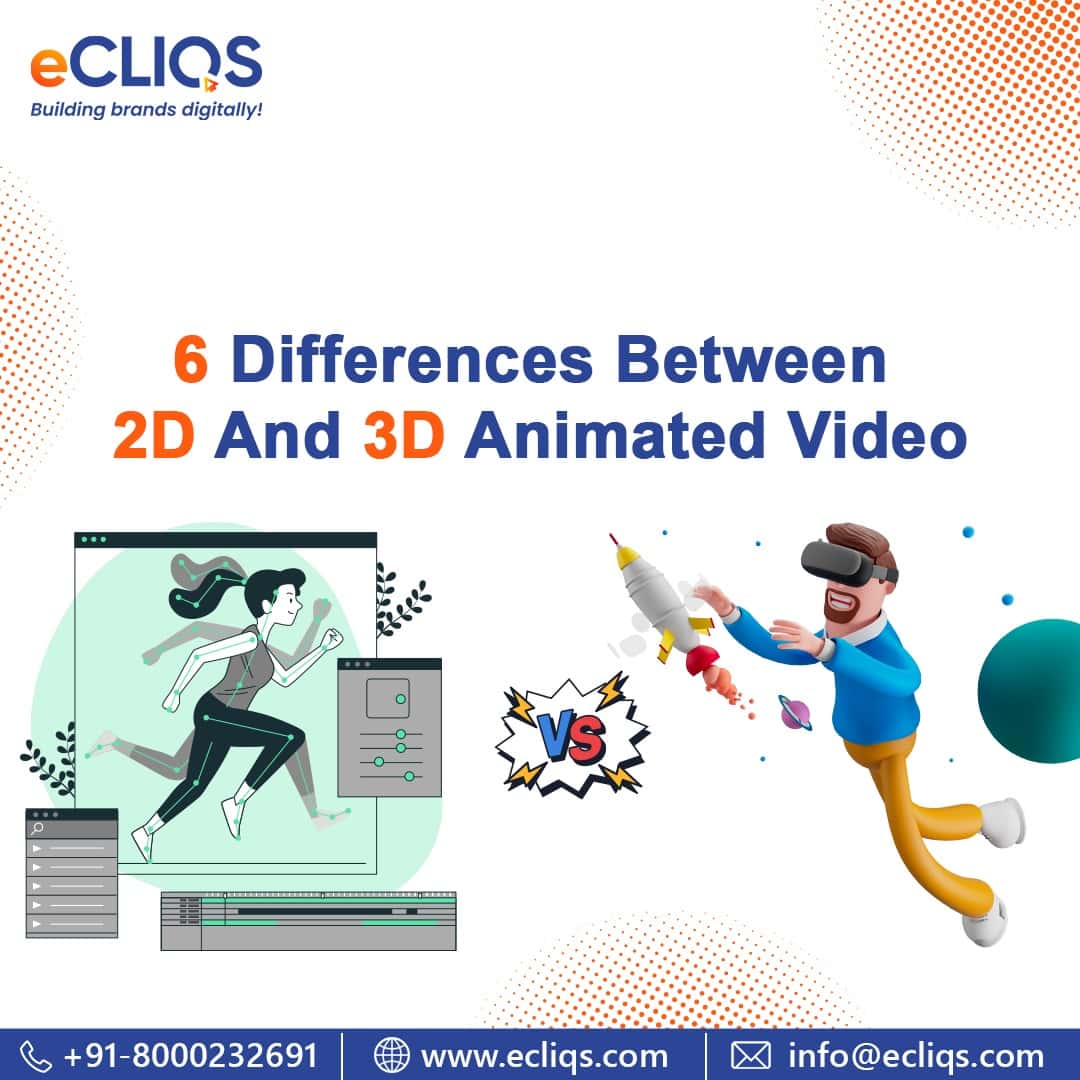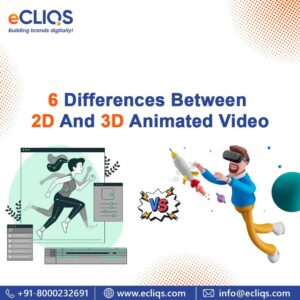
An animated explainer video requires you to be familiar with a wide range of styles and techniques. When contacting an animation business, the first question they may ask you is whether you prefer 2D or 3D animation. In the video production process, the flow will be defined by the use of these two basic animation styles. We’ll go over the differences between the two, as well as how much they cost. Learn more about all of this by reading on!
What is a 2D animation explainer video?
2D explainer videos, as the name implies, are used to explain a topic in two dimensions. x and y are the only two planes in a 2D animation. Basically, it’s just a two-dimensional picture. There is a length and a width to this image.
2-dimensional video includes all graphics and cartoons you see on television, whether computer-generated or hand-drawn. Several well-known cartoon characters are Tom and Jerry, Mickey Mouse, Phineas and Ferb, and the like.

(source:https://static.rfstat.com/bloggers_folders/ec7696c0-fd02-437b-b8d5-e3bd8b464f36.jpg)
A 2D animation explainer film uses two dimensions to illustrate anything. They can only explain things using the ‘x’ and ‘y’ axis. There are only a few frames per second in the 2D animation explainer videos that you see in PowerPoint.
About 24 to 29 frames per second are typical for a 2D animation explainer film. Whiteboard explainer videos, in particular, use animations displayed at a frame rate of 5-10 frames per second. An animator’s skill level and the animation programme they utilise determine the frame rates.
What is a 3D animation explainer video?
In order to create a two-dimensional image, one must have a great deal of skill. 3-D objects can be created by adding extra dimension to a 2-D item. A 3D object has mass and takes up a specific amount of room. Shrek, Rapunzel, Toy Story, or Up are all excellent examples of 3D animation.

(source:https://webneel.com/sites/default/files/images/manual/vdo/animation-3d%20(1).jpg)
In order to fully convey a topic, a 3D animation explainer film makes use of three dimensions. Depending on the keyframe, explainer videos like this can go anywhere from 30 to 60 frames per second. Additionally, the animation video software is critical. Using a 3D animation explainer film is essential since it allows you to show things more realistically. In advertising, a 3D animation explainer film is frequently used to convey a product’s features and benefits to the audience.
Here are 6 differences between 2D and 3D animated video

1. Visual Experience
Visually, 2D animated video is less realistic since it only deals with the length and width of a 2-dimensional environment.
Visuals made in 3D have three dimensions: width, height, and thickness. 3D animations benefit from this because it gives them a more realistic appearance and increases their sense of depth.
2. Flexibility of Revisions
Due to its greater realism, 3D animated video typically appears to be better looking than 2D animation, but it is also more difficult to make changes because of the additional complexity.
Why is it complex?
In a nutshell, mechanical processes include:
- Modeling —process of creating a 3D mesh by starting with a shape and moulding it into the desired shape.
- Texturing — It’s at this point that the creative process truly begins, as we begin to dress the 3D model.
- Animation— movements of the subject and surroundings.
- Lighting — texture, camera angles, and the like.
- Rendering — the final and most important phase in the manufacturing of 3D animated video production.
As a result, due to the aforementioned technological and mechanical difficulties, the editing and revision process in 3D animation is made more difficult.
The 2D animation drawing style allows for character modifications to be simple with this type of animated film.
3. Production Time
To reduce time, 2D animation uses a drawing process that is more “flexible,” while 3D animation employs full computerization, making it more difficult.
Of course, the outcome will be different as well.
It’s possible to observe every angle of a character in a 3D animation, unlike in 2D animation, when you can only see one perspective.
Creating high-quality animation in any medium takes time, but 3D animation requires more of it due to the difficulty in achieving a more detailed product.
4. Frame Rates
Animating in 2D entails drawing a lot, but the FPS and movement also make a difference. That’s a little confusing. In 3D animation, we typically operate at a frame rate of 24 fps. In 2D animation, this means that each of the 24 frames in a second contains an illustration. A lot of drawing sounds like a lot more work than it is.
For two frames, you can maintain the same drawing in place. That’s a frame rate of 12 images per second. It’s termed “working on twos” because every two frames you’re introducing a new illustration or change to an existing one. You can even work on threes and fours, making a new drawing every three or four frames, if the movement is extremely slow.
In certain cases, a single drawing is shown for a long period of time. 3D, on the other hand, isn’t truly like that. For even one frame of animation, it appears as if the 3D character is completely still and lifeless. Although we can get away with just one new drawing every three to five frames in 2D and stop-motion animations, we must always keep the subject moving in 3D. Not an easy task, either!
5. Cost
When compared to 3D animated videos, 2D animated videos are cheaper. That’s mostly due to the difficulty and time-consuming nature of making a 3D animated film.
In general, a 3D animated video will cost you three times the price of a 2D animated video.
6. Platform
Traditional drawing methods are used in the creation of 2D animated videos. A pencil sketch or a computer-generated animation are the two most common methods of creating a character’s movements and expressions. Adobe After Effects and Adobe Animate are 2D animated video creation tools that aid in the digital addition of movements.
3D animated video creation, on the other hand, is all done through computer software. Modelling, rigging, and texturing are just a few of the phases that make up this process.
What’s better: 2D or 3D animated video?
To be honest, there isn’t a single correct solution to this one. There is a lot that goes into it, and it all comes down to the animator. Advertising and instructive videos can benefit greatly from both of these approaches. 3D animated video has several advantages over 2D animated video, but it’s more expensive to make. More people are involved in 3D animated video production than in 2D animation. As a result, the whole production time is substantially increased. As a result of this, 3D animated videos appear more lifelike than 2D ones. If you’d like to make a video that incorporates both 2D and 3D elements, bear that in mind.
Conclusion
Writing, storyboarding, illustration, animation, voice acting and sound design are just a few of the tasks involved in creating an animated video. 2D and 3D animated video are the two most common types of animated video. In this article, we’ve taken a close look at both of them. You can always consult with experts at e-Cliqs to get a better understanding of what types of animated video will suit your requirements the best.
References
- https://explain.ninja/blog/2d-animated-videos-vs-3d-animated-videos-whats-the-difference/https://www.lcca.org.uk/blog/education/differences-between-2d-and-3d-animation/
- https://breadnbeyond.medium.com/2d-and-3d-animation-production-4b26d18790c5
- https://www.dbswebsite.com/blog/what-is-the-difference-between-3d-and-2d-animation/
- https://buzzflick.com/difference-between-2d-animation-and-3d-animation/
- https://school.mangoanimate.com/differences-between-2d-3d-animation-explainer-video/


